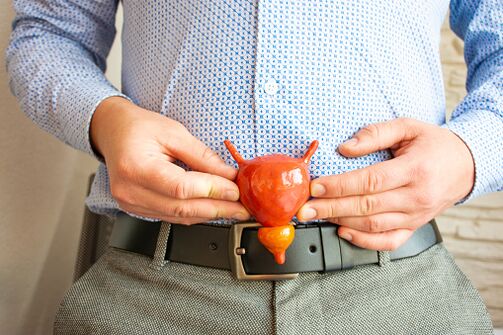Prostatitis is not the most pleasant disease, which often becomes chronic. Any provocation by behavior, well-being and symptoms reappear: pain in the genital area, painful urination, unstable erection.

The first prevention of prostatitis is a simple and healthy lifestyle without special prohibitions. Secondary prevention of the onset of the disease is a number of measures, including diet, complete rejection of alcohol, and, of course, appropriate medications.
What are the risk factors for the onset of the disease?
Prostatitis can develop with a combination of two factors: the appearance of infections and stagnant processes in the body.
The main sources of pathogens are:
- intestines and diseases such as Escherichia coli, Klebsiella, Proteus, etc. ;
- a sexual partner with infectious diseases of the genitourinary system - chlamydia, mycoplasma;
- throat infections, untreated decayed teeth, sore tonsils;
- low physical activity
All this individually and together can lead to the development of prostatitis.
Physical activity and prevention of prostatitis.
Low physical activity is the main reason for the development of prostatitis in adults and young men. Prostatitis against the background of venous stasis in the pelvic organs is called congestive.
If a man leads an active and healthy lifestyle, his muscles in the pelvic region are constantly in good shape. They support the genitals well enough in the correct position, and the whole system works well.
Don't have time for a gym and special classes? It is not a problem! Simple enough, but regular exercise and gymnastics every day. Exercises should be done for at least 15-30 minutes until the sweat starts to shine, that is, until there is light physical activity.
Kegel exercises are suitable for warm-up as prevention of prostatitis. However, it is important to know that they cannot be performed if kidney stones are present.Prevention of prostatitis at home In addition, for the prevention of prostatitis, brisk walking uphill is also suitable, swimming and jogging are perfect.
With the right seat, a bike will do just fine. Improves blood circulation in the pelvic organs. Cycling between 5 and 7 kilometers 2-3 times a week can be an excellent prevention of prostatitis.
Regular sex plays an important role in preventing prostatitis. Sex should not be "for show, " but in the context of mutual desire and satisfaction. Poor orgasms are not the way to keep your prostate in good shape. The arousal must be real and the hormones must be in order, only then will prevention work one hundred percent.
Separately, it should be said about the hygiene of sexual intercourse. This is also very important. Many couples trying to diversify their sexual relationships simply forget about basic hygiene. Unprotected sex often becomes the cause of prostate infection and, as a result, the development of prostatitis.
Proper nutrition, regular and high-quality sex, the absence of bad habits - all this together will bring good male health and the absence of prostate diseases.
Products for the prevention of prostatitis.
Proper nutrition and high-quality healthy foods will help protect the body from harmful effects. What foods will be especially helpful in protecting against the prostate? Here is just a small list:
- Pumpkin seeds. On an empty stomach, you should eat 30 to 40 seeds for at least 7 days in a row. It will be useful to use them together with honey or nuts;
- fatty fish rich in omega-3, also shellfish;
- healthy herbs: parsley, lettuce, celery, basil;
- walnuts
Of course, nutrition plays an important role in preventing prostatitis and many other male health conditions.
Spicy dishes, beer in the evenings, nuts and crackers with spices only provoke new symptoms of the development of the disease. Symptoms of the disease can appear immediately after eating the wrong food. Then, the treatment will have to start from the beginning.
Well, of course, don't forget about regular medical exams. After age 40, all men should visit a urologist at least once every six months. Just as women should visit a gynecologist. At this age, the risks of developing prostatitis increase.




































